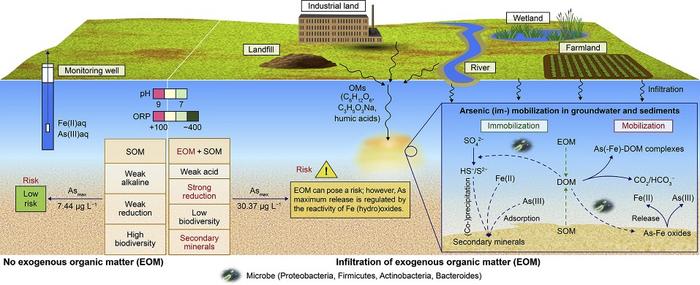Researchers from the Chinese Research Academy of Environmental Sciences have conducted a study to assess the impact of environmental factors and microbial communities on the mobilization of arsenic (As). The findings, published in Volume 15 of the journal Environmental Science and Ecotechnology, reveal important insights into the biogeochemical processes involved in As release. The study focused on processes such as desorption, reduction, complexation, and co-precipitation that affect the As behaviour in the environment. The interaction between Fe (hydro) oxides and organic matters (OMs), particularly dissolved organic matter (DOM), was identified as a crucial control mechanism. The OMs were characterized using fluorescence indices, which indicated sustained biological activities throughout the experimental period. The microbial community analysis unveiled the presence of bacteria capable of reducing Fe, Mn, and As, as well as bacteria involved in metabolic transformations using EOM. When bio-reactive and chemically reactive OMs were introduced, they created a reduction environment facilitating the release of As, Fe, and Mn, particularly at high OM concentrations. Glucose and sodium lactate, easily metabolized by microorganisms, resulted in higher releases than the control group without OMs. The addition of humic acid (HA), a chemically reactive OM, significantly influenced the release of Fe and Mn, albeit with a lesser impact on As. The study also observed the formation of secondary Fe minerals, such as siderite and mackinawite, which incorporated As and contributed to the decline in As, Fe, and Mn concentrations in the aqueous phase. Microbial decomposition altered the characteristics of DOM, leading to the production of amino acids and the presence of polysaccharides, as indicated by specific functional groups. Furthermore, the research employed canonical correspondence analysis (CCA) and redundancy analysis (RDA) to examine the relationship between environmental factors, the microbial community, and As mobilization. Positive correlations were found between As(III), Fe, and Mn, while a negative correlation was observed with oxidation-reduction potential (ORP). Several bacterial genera associated with As metabolism were identified, underscoring their role in the release process.

Credit: Environmental Science and Ecotechnology
Researchers from the Chinese Research Academy of Environmental Sciences have conducted a study to assess the impact of environmental factors and microbial communities on the mobilization of arsenic (As). The findings, published in Volume 15 of the journal Environmental Science and Ecotechnology, reveal important insights into the biogeochemical processes involved in As release. The study focused on processes such as desorption, reduction, complexation, and co-precipitation that affect the As behaviour in the environment. The interaction between Fe (hydro) oxides and organic matters (OMs), particularly dissolved organic matter (DOM), was identified as a crucial control mechanism. The OMs were characterized using fluorescence indices, which indicated sustained biological activities throughout the experimental period. The microbial community analysis unveiled the presence of bacteria capable of reducing Fe, Mn, and As, as well as bacteria involved in metabolic transformations using EOM. When bio-reactive and chemically reactive OMs were introduced, they created a reduction environment facilitating the release of As, Fe, and Mn, particularly at high OM concentrations. Glucose and sodium lactate, easily metabolized by microorganisms, resulted in higher releases than the control group without OMs. The addition of humic acid (HA), a chemically reactive OM, significantly influenced the release of Fe and Mn, albeit with a lesser impact on As. The study also observed the formation of secondary Fe minerals, such as siderite and mackinawite, which incorporated As and contributed to the decline in As, Fe, and Mn concentrations in the aqueous phase. Microbial decomposition altered the characteristics of DOM, leading to the production of amino acids and the presence of polysaccharides, as indicated by specific functional groups. Furthermore, the research employed canonical correspondence analysis (CCA) and redundancy analysis (RDA) to examine the relationship between environmental factors, the microbial community, and As mobilization. Positive correlations were found between As(III), Fe, and Mn, while a negative correlation was observed with oxidation-reduction potential (ORP). Several bacterial genera associated with As metabolism were identified, underscoring their role in the release process.
Highlights
•Groundwater arsenic mobilization regulated by exogenous organic matter (EOM) was revealed.
•Reactivity of Fe (hydro)oxides and SO42− reduction control groundwater As level.
•Secondary risk of anthropogenic EOM for groundwater As and Mn release merit noting.
The research significantly enhances our understanding of the intricate factors influencing the release of arsenic (As) and sheds light on the microbial processes involved in As mobilization in aquatic environments. The findings have important implications for managing and mitigating groundwater pollution caused by the infiltration of EOM. Specific sites, such as landfills, petrochemical sites, and managed aquifer recharge projects, are identified as particularly vulnerable to contamination. Further investigations are necessary to explore the effects of hydrodynamics and hydrogeochemical environments in practical applications. These findings underscore the need for comprehensive strategies to effectively control and mitigate the environmental risks associated with EOM infiltration, aiming to safeguard groundwater quality.
###
References
DOI
10.1016/j.ese.2023.100243
Funding information
National Key Research and Development Program (2019YFC1806204)
National Natural Science Foundation of China (No. 41907178).
About Environmental Science and Ecotechnology
Environmental Science and Ecotechnology (ISSN 2666-4984) is an international, peer-reviewed, and open-access journal published by Elsevier. The journal publishes significant views and research across the full spectrum of ecology and environmental sciences, such as climate change, sustainability, biodiversity conservation, environment & health, green catalysis/processing for pollution control, and AI-driven environmental engineering. ESE received its latest impact factor of 12.6, according to the Journal Citation ReportTM 2022.
Journal
Environmental Science and Ecotechnology
DOI
10.1016/j.ese.2023.100243
Method of Research
Experimental study
Subject of Research
Not applicable
Article Title
Exogenous-organic-matter-driven mobilization of groundwater arsenic
Article Publication Date
27-Feb-2023
COI Statement
The authors declare that they have no competing interests




